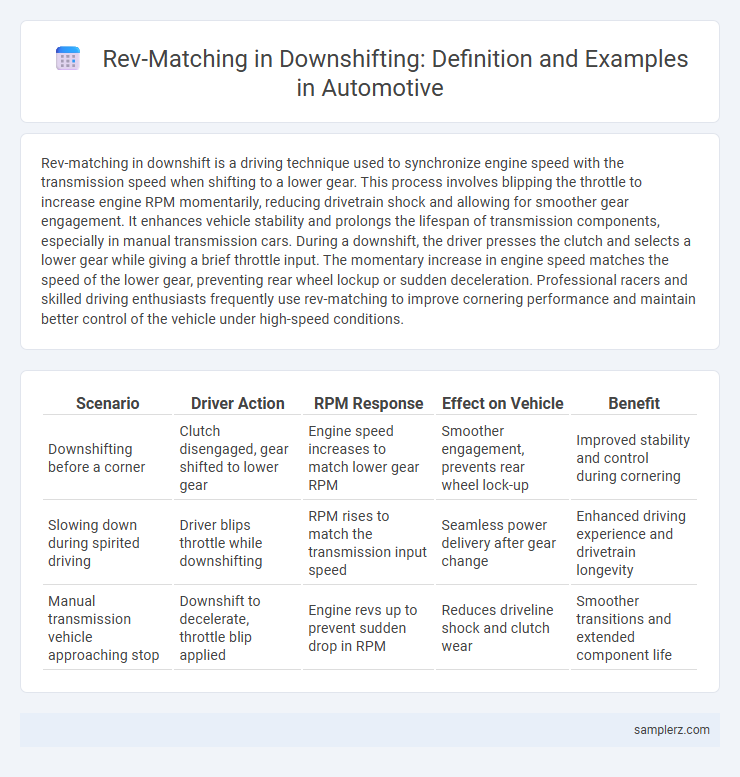Rev-matching in downshift is a driving technique used to synchronize engine speed with the transmission speed when shifting to a lower gear. This process involves blipping the throttle to increase engine RPM momentarily, reducing drivetrain shock and allowing for smoother gear engagement. It enhances vehicle stability and prolongs the lifespan of transmission components, especially in manual transmission cars. During a downshift, the driver presses the clutch and selects a lower gear while giving a brief throttle input. The momentary increase in engine speed matches the speed of the lower gear, preventing rear wheel lockup or sudden deceleration. Professional racers and skilled driving enthusiasts frequently use rev-matching to improve cornering performance and maintain better control of the vehicle under high-speed conditions.
Table of Comparison
| Scenario | Driver Action | RPM Response | Effect on Vehicle | Benefit |
|---|---|---|---|---|
| Downshifting before a corner | Clutch disengaged, gear shifted to lower gear | Engine speed increases to match lower gear RPM | Smoother engagement, prevents rear wheel lock-up | Improved stability and control during cornering |
| Slowing down during spirited driving | Driver blips throttle while downshifting | RPM rises to match the transmission input speed | Seamless power delivery after gear change | Enhanced driving experience and drivetrain longevity |
| Manual transmission vehicle approaching stop | Downshift to decelerate, throttle blip applied | Engine revs up to prevent sudden drop in RPM | Reduces driveline shock and clutch wear | Smoother transitions and extended component life |
Understanding Rev-Matching: The Basics in Automotive Downshifting
Rev-matching in automotive downshifting involves synchronizing the engine speed with the transmission speed to ensure a smooth gear transition and avoid drivetrain shock. When downshifting, the driver blips the throttle to raise the engine RPM to match the lower gear's speed, reducing clutch wear and enhancing vehicle control. Mastering this technique improves performance driving and extends the lifespan of transmission components.
Why Rev-Match Matters During Downshift
Rev-matching during downshift is crucial for maintaining engine and transmission harmony, preventing drivetrain shock that can cause premature wear. Proper rev-match ensures smoother gear transitions, enhancing vehicle control and stability, especially in performance driving or challenging road conditions. This technique reduces the risk of rear-wheel lockup, improving traction and safety while enabling more efficient and responsive acceleration.
Step-by-Step Guide to Performing a Rev-Match Downshift
To perform a rev-match downshift, begin by pressing the clutch and shifting into a lower gear. Next, gently blip the throttle to raise engine RPM to match the speed of the lower gear. Release the clutch smoothly to ensure a seamless transition and prevent drivetrain shock.
Real-World Example: Rev-Matching in a Manual Transmission
In a real-world example of rev-matching during a downshift in a manual transmission, the driver blips the throttle to increase engine RPMs, synchronizing the engine speed with the lower gear before engaging the clutch. This technique prevents drivetrain shock, ensures smoother gear transitions, and enhances vehicle control during deceleration. Rev-matching is essential for performance driving and prolongs the lifespan of the transmission components.
Common Mistakes When Attempting Rev-Match Downshifts
Common mistakes when attempting rev-match downshifts include failing to blip the throttle adequately, causing engine lugging or harsh engagement. Drivers often misjudge timing, resulting in a mismatch between engine speed and transmission input shaft speed, which stresses the clutch and drivetrain components. Ignoring smooth coordination between braking, clutch release, and throttle blip leads to jerky shifts and accelerated wear on synchronizers.
Benefits of Rev-Matching for Engine Longevity
Rev-matching in downshifting synchronizes engine speed with transmission input, reducing driveline shock and preventing excessive wear on the clutch and gearbox. This technique minimizes stress on engine components, enhancing longevity by promoting smoother gear transitions and optimal RPM alignment. Consistent use of rev-matching helps maintain engine health, leading to improved performance and a longer-lasting drivetrain.
Rev-Match Downshift: Impact on Vehicle Performance
Rev-match downshifting synchronizes engine speed with the transmission, minimizing drivetrain shock and enhancing smoothness during gear changes. This technique reduces wear on the clutch and transmission components, leading to improved longevity and reliability. By optimizing engine RPM alignment, rev-match downshift contributes to better acceleration response and overall vehicle performance.
Rev-Matching Techniques: Heel-Toe vs. Traditional Methods
Rev-matching techniques enhance smooth downshifts by synchronizing engine speed with wheel speed, minimizing drivetrain shock. Heel-toe rev-matching involves using the right foot to brake and blip the throttle simultaneously, allowing precise control and quicker transitions compared to traditional double-clutching methods. This technique is favored in performance driving and racing for maintaining vehicle balance and reducing wear on the transmission.
How Rev-Match Downshifting Enhances Driving Experience
Rev-match downshifting synchronizes engine speed with wheel speed during gear changes, resulting in smoother transitions and reduced drivetrain shock. This technique improves vehicle stability by preventing sudden deceleration and wheel lock-up, enhancing control especially in performance driving or sharp cornering. By minimizing engine braking harshness, rev-match downshifting delivers a more responsive and enjoyable driving experience, preserving clutch lifespan and optimizing overall vehicle performance.
Advanced Tips for Perfecting Rev-Match Downshift Execution
Executing a flawless rev-match downshift requires precise throttle blipping to synchronize engine RPM with the lower gear speed, minimizing drivetrain shock and enhancing vehicle stability. Advanced techniques include anticipating the clutch engagement point and modulating throttle input based on engine load and road conditions to achieve smoother transitions. Utilizing sensors and real-time feedback from performance driving data can further refine timing and throttle precision for expert-level downshift control in high-performance vehicles.

example of rev-match in downshift Infographic
 samplerz.com
samplerz.com